| {3} | {4} | {7/2} | {7} |
| 28 | 28 | 8 | 0 |
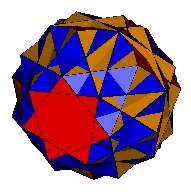
VRML OFF
| {3} | {4} | {7/2} | {7} |
| 28 | 35 | 7 | 0 |
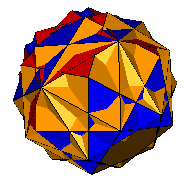
VRML OFF
| {3} | {4} | {7/2} | {7} |
| 14 | 7 | 1 | 7 |
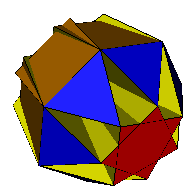
VRML OFF
| {3} | {4} | {7/2} | {7} |
| 7 | 14 | 0 | 7 |
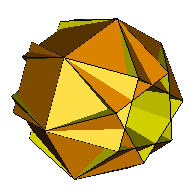
VRML OFF
Self Augmented Heptagonal Semi-Cupolas and Edge-Facetings
 VRML OFF |
 VRML OFF |
||||||||||||||||
 VRML OFF |
 VRML OFF |
The heptagonal {7/2}-semi-cupola can be augmented (inwards) with seven further {7/2}-semi-cupolas to form the top left figure above. This process can be performed for any cupola or semi-cupola, but the heptagonal case is unique as the added semi-cupolas all share a common point. In the augmented figure, this becomes a degenerate double vertex where each of the pair is a 4^7 vertex.
Three edge- facetings can be formed from this figure. The first (top right) is formed by removing the original semi-cupola, this also contains the degenerate double vertex. The lower two cases are formed by selecting different faces in the original model, in these cases the {7/2} heptagrammic faces (red) are replaced by heptagons (yellow) and the square faces making up the degenerate vertices are replaced by triangles. The edge-faceting in the lower left is still degenerate though as the 7-4-3 vertices occur in co-incident pairs. The lower right example has no degenerate vertices. It can be proved that no further edge-facetings exist.
As the lower two cases (again separated by the removal of the original semi-cupola) contain 7-4-3 acrons they are examples of 7-4-3 acrohedra.
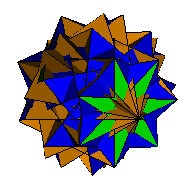 VRML OFF |
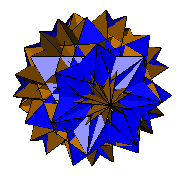 VRML OFF |
||||||||||||||||
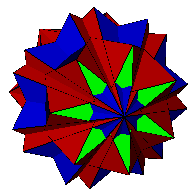 VRML OFF |
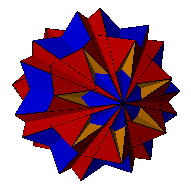 VRML OFF |
The same process can also be performed using the 'crossed' {7/4}-semi-cupola. The common vertex again exists and the same edge-facetings can be formed. The yellow heptagons in the original edge-facetings are replaced here by {7/2} heptagrams (red), and the {7/2} heptagrams are replaced by {7/3} heptagrams (green).
Relationship between Heptagonal Polyhedra
It is fascinating to see the relationship between the self-augmented heptagonal cupola, the 7-7-3 acrohedron and the 7-6-4 acrohedron. The latter two can be regarded as expansions of the former. The above image (and linked VRML) shows all three polyhedra around a common centre (the centroid of the heptagonal vertices, one heptagon in each polyhedron has been highlighted. The three heptagons lie in parallel planes and the equivalent vertices of each heptagon are co-linear. Note the lower left edge-faceting of the self-augmented heptagonal cupola has been used.
Credits:
See also: